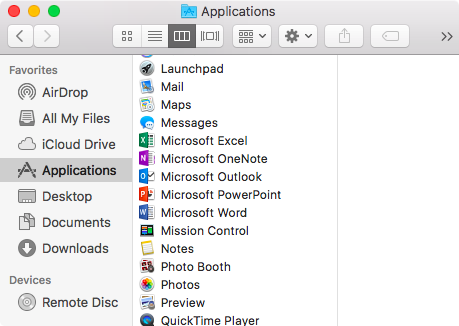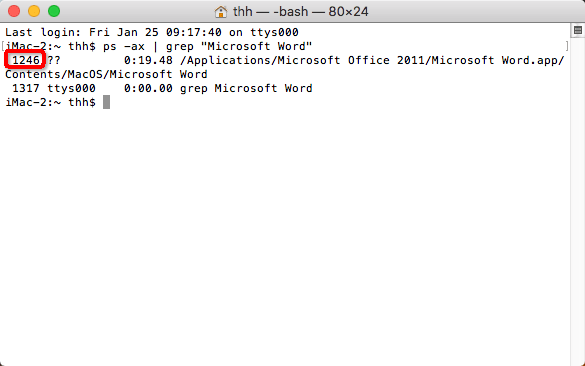When using apps/programs on the computer, sometimes one program might experience long pauses or periods of unresponsiveness. You even cannot close the program by clicking the X button in its upper right corner. In this case, you would want a way to force the program to quit. Now, this post will show you three ways to force an unresponsive program to quit in Windows 10.
- When a program freezes up or does not respond for a long while and the X button does not work, you can try to force it to quit by pressing the Alt + F4 key on your physical keyboard. The Alt + F4 keyboard shortcut can force a program to quit when the program’s window is selected and active.
- Situation 1: The unsaved word document is caused by force quit, program or system crash, but the Mac is not powered off. In this case, no matter you can find the unsaved file or not, can remember the file name or not, you just need to open any one of your word documents, then the Office Word will be launched.
Jan 28, 2016 Microsoft word tutorial How to insert images into word document table - Duration: 7:11. How to force quit an application on a mac - Duration: 0:58. Howtwos101 115,377 views.
Microsoft Force Quit Program
Way 1: Force an unresponsive program to quit using keyboard shortcut
Microsoft Word Online
When a program freezes up or does not respond for a long while and the X button does not work, you can try to force it to quit by pressing the Alt + F4 key on your physical keyboard. The Alt + F4 keyboard shortcut can force a program to quit when the program’s window is selected and active. When no window is selected, pressing Alt + F4 will force your computer to shut down.
Tips: Alt + F4 might not work for some cases. If Alt + F4 doesn’t work for your case, use any of the methods below.
Way 2: Force an unresponsive program to quit using Task Manager
Task Manager is the most common way to quickly end a process or program on Windows computer.
Step 1: Open the Task Manager by pressing Ctrl + Shift + Esc keyboard shortcut or by right-clicking on your Windows 10 taskbar and then selecting Task Manager.
Step 2: If the Task Manager is displayed with a simple interface, click the More details button on the lower left corner to display its full screen.
Step 3: Select the Processes tab, and you will find the unresponsive program under the Apps section. To force the program to quit, just click on the program to highlight it, and then click the End task button in the lower right corner of the Task Manager window, or right-click on the program, and select End task.
Way 3: Force an unresponsive program to quit using Command Prompt
Sometimes, even Task Manager might not work. Then you have to use Command Prompt to terminate an unresponsive program. Here are the steps.
Step 1: Open a Command Prompt window by pressing Win + X and then select Command Prompt.
Step 2: Type tasklist and press Enter key. This will list all currently running tasks and programs on the computer. You can find the unresponsive program’s name from the list.
Step 3: Type taskkill /im program_name.exe and press Enter key. For example, in my case, I want to force the Excel program (i.e. Excel.exe) to quit, so I type taskkill /im excel.exe and press Enter. If everything went right, the command will run successfully, and the message 'Sent termination signal to the process Excel.exe with PID 5972' is displayed on the screen. The PID means the Process id which was defined by the Windows system.
Related Articles
- 2 Ways to Uninstall Programs or Apps in Windows 10
- How to Block a Program from Accessing the Internet in Windows 10
- How to Uninstall and Reinstall Photos App in Windows 10
 -->
-->Note
Office 365 ProPlus is being renamed to Microsoft 365 Apps for enterprise. For more information about this change, read this blog post.
Symptoms
When you start Microsoft Word for Mac, or when you try to open a new document, you experience one of the following conditions:
The program closes unexpectedly.
Error message:

Note
I Can Force Quit Microsoft Word On My Mac Pro
This error message may also occur during usage of application such as saving a document.
Resolution
To resolve this problem, follow steps below.
I Can Force Quit Microsoft Word On My Mac Keeps Freezing
Microsoft Word for Mac 2008 or Later
Step 1: Quit all applications
On the Apple menu, click Force Quit.
Select an application in the 'Force Quit Applications' window.
Click Force Quit.
Repeat the previous steps until all active applications.
Warning
When an application is force quit, any unsaved changes to open documents are not saved.
Step 2: Remove Preferences
Quit all Microsoft Office for Mac programs.
On the Go menu, click Home.
Open Library.
Note
The Library folder is hidden in MAC OS X Lion. To display this folder, hold down the OPTION key while you click the Go menu.
Open the Preferences folder.
Look for a file that is named com.microsoft.Word.plist.
If you locate the file, move it to the desktop. If you do not locate the file, the program is using the default preferences.
If you locate the file and move it to the desktop, start Word, and check whether the problem still occurs. If the problem still occurs, quit Microsoft Word, and restore the file to its original location. Then, go to the next step. If the problem seems to be resolved, you can move the com.microsoft.Word.plist file to the trash.
Quit all Microsoft Office for Mac programs.
On the Go menu, click Home.
Open Library.
Note
The Library folder is hidden in MAC OS X Lion. To display this folder, hold down the OPTION key while you click the Go menu.
Open the Preferences folder.
Open the Microsoft folder.
Locate the file that is named com.microsoft.Word.prefs.plist.
Move the file to the desktop.
Start Word, and check whether the problem still occurs. If the problem still occurs, quit Word, and restore the file to its original location. Then, go to the next step. If the problem seems to be resolved, you can move the com.microsoft.Word.prefs.plist file to the trash.
On the Go menu, click Home.
Open Library.
Note
The Library folder is hidden in MAC OS X Lion. To display this folder, hold down the OPTION key while you click the Go menu.
Open the Application Support folder.
Open the Microsoft folder.
Open the Office folder.
Open the User Templates folder.
Locate the file that is named Normal, and move the file to the desktop.
Start Word and check whether the problem still occurs. If the problem seems to be resolved, you can move the Normal file to the Trash. If the issue continues to occur, proceed to the next step.
If the issue continues to occur, go to the next step.
Step 3: Peform clean boot
For information how to clean start your Operating system (OS), see Microsoft Knowledge Base article:
2398596 How to use a 'clean startup' to determine whether background programs are interfering with Office for Mac
If the issue continues to occur in Safe mode, go to the next step.
Step 4: Remove and then reinstall Office
For information how to remove and then reinstall Office, see the following article:
If after removing and then reinstalling Office, the problem continues to occur, go to the next step.
Step 5: Use the 'Repair Disk Permissions' option
You can use the Repair Disk Permissions option to troubleshoot permissions problems in Mac OS X 10.2 or later versions. To use the Repair Disk Permissions option, follow these steps:
- On the Go menu, click Utilities.
- Start the Disk Utility program.
- Click the primary hard disk drive for your computer.
- Click the First Aid tab.
- Click Repair Disk Permissions.
Note
The Disk Utility program only repairs software that is installed by Apple. This utility also repairs folders, such as the Applications folder. However, this utility does not repair software that is in your home folder.
Microsoft Word 2004 for Mac
Quit all Microsoft Office for Mac programs.
On the Go menu, click Home.
Open Library.
Note
The Library folder is hidden in MAC OS X Lion. To display this folder, hold down the OPTION key while you click the Go menu.
Open the Preferences folder.
Look for a file that is named com.microsoft.Word.plist.
If you locate the file, move it to the desktop. If you do not locate the file, the program is using the default preferences.
If you locate the file and move it to the desktop, start Word, and check whether the problem still occurs. If the problem still occurs, quit Word, and restore the file to its original location. Then, go to the next step. If the problem seems to be resolved, you can move the com.microsoft.Word.plist file to the trash.
Qit all Microsoft Office for Mac programs.
On the Go menu, click Home.
Open Library.
Note
The Library folder is hidden in MAC OS X Lion. To display this folder, hold down the OPTION key while you click the Go menu.
Open the Preferences folder.
Open the Microsoft folder.
Look for a file that is named com.microsoft.Word.prefs.plist.
Move the file to the desktop.
Start Word, and check whether the problem still occurs. If the problem still occurs, quit Word, and restore the file to its original location. Then, go to the next step. If the problem seems to be resolved, you can move the com.microsoft.Word.prefs.plist file to the trash.
On the Go menu, click Home.
Open the Documents folder.
Open the Microsoft User Data folder.
Locate the file that is named Normal, and move the file to the desktop.
Start Word, and check whether the problem still occurs. If the problem seems to be resolved, you can move the Normal file to the trash.

Third-party disclaimer information
The third-party products that this article discusses are manufactured by companies that are independent of Microsoft. Microsoft makes no warranty, implied or otherwise, about the performance or reliability of these products.
The information and the solution in this document represent the current view of Microsoft Corporation on these issues as of the date of publication. This solution is available through Microsoft or through a third-party provider. Microsoft does not specifically recommend any third-party provider or third-party solution that this article might describe. There might also be other third-party providers or third-party solutions that this article does not describe. Because Microsoft must respond to changing market conditions, this information should not be interpreted to be a commitment by Microsoft. Microsoft cannot guarantee or endorse the accuracy of any information or of any solution that is presented by Microsoft or by any mentioned third-party provider.



